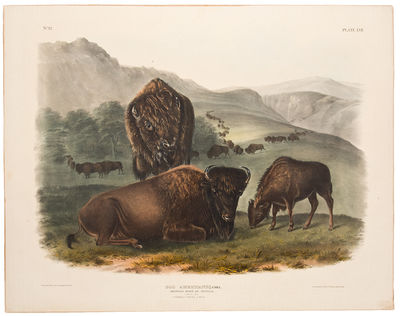1849 · New York
by AUDUBON, John James (1785-1851), AUDUBON, John Woodhouse (1812-1862, Artist), BACHMAN, Reverend John (1790-1874, Naturalist)
New York: John James Audubon, 1849. First edition hand-colored lithograph by John T. Bowen of Philadelphia after John James Audubon. Sheet: (22 x 28 inches). An iconic image of Western Americana from the folio first edition of Audubon's "Quadrupeds of North America," the greatest work of natural history illustration produced in America during the nineteenth century: "As long as our civilization lasts, America will be in debt to this genius." [Peterson]
This fine plate is from the folio edition of Audubon's The Viviparous Quadrupeds of North America, which was produced entirely in the United States. The work was Audubon's last, and by 1846 he
(truncated) had to hand over the drawing of the final fifty plates to his sons, John Woodhouse and Victor Audubon. The production of the Quadrupeds was begun by Audubon and his sons at about the same time as the commercially-successful octavo edition of The Birds of America. Unlike the double-elephant folio, the Quadrupeds was produced entirely in the United States. Reese notes that "By 1843, the Audubon family business was a well-oiled machine, involving John James, his two sons, and various in-laws and friends. The octavo Birds was still in production when Bowen began to produce the plates for the folio edition of the Quadrupeds, the largest successful color-plate book project of 19th-century America. It took the family five years to publish 150 plates in thirty parts. The massive project was a commercial success, thanks to the close management of Victor. There were about three hundred subscribers." [Reese] Like Birds of America, the Viviparous Quadrupeds was intended to be a comprehensive visual catalog of North America animalia, with Audubon's focus here shifting from birds to four-legged land mammals. Accompanying each image was correlating didactic text, written primarily by Bachman, that informed the reader of the animal's habits, diet, habitat, and gestational period. Totaling 150 prints, the project was rushed to completion as Audubon's health declined. Emerging in the shadow of its acclaimed predecessor, Birds of America, the Viviparous Quadrupeds has not received the adequate attention nor recognition it so richly deserves. This image is of a family of American buffalo, the most iconic animal indigenous to North America, whose presence was integral for Native American life, and whose near-extinction spurred on the conservation movement in the US. The buffalo is today the state animal of Kansas, Oklahoma, and Wyoming.
Bennett, p.5. Peterson, Birds of America, passim. Reese Stamped with a National Character 36. Sabin 2367. Wood, p.209. (Inventory #: 35434)


